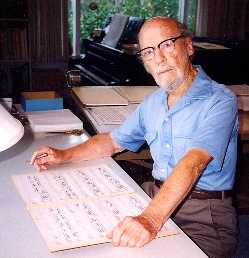Difference between revisions of "Read, Gardner"
| Line 1: | Line 1: | ||
| − | [[Image: | + | [[Image:GardnerRead.jpg|right|thumb|250px|Gardner Read]] |
== Biography == | == Biography == | ||
| Line 16: | Line 16: | ||
-------------------------------------------- | -------------------------------------------- | ||
| − | + | Gardner Read (January 2, 1913 in Evanston, Illinois – November 10, 2005 in Manchester-by-the-Sea, Massachusetts) was an American composer and musical scholar. | |
| − | + | ||
| + | His first musical studies were in piano and organ, and he also took lessons in counterpoint and composition at the School of Music at Northwestern University. In 1932 he was awarded a four-year scholarship to the Eastman School of Music (B.M. and M.M.), where he studied with Bernard Rogers and Howard Hanson. In the late 1930s he also studied briefly with Ildebrando Pizzetti, Jean Sibelius and Aaron Copland. | ||
| + | |||
| + | After heading the composition departments of the St. Louis Institute of Music, the Kansas City Conservatory of Music and the Cleveland Institute of Music, Read became Composer-in-Residence and Professor of Composition at the School of Music at Boston University. He remained in this post until his retirement in 1978. | ||
| + | |||
| + | His Symphony No. 1, op. 30 (1937, premiered by Sir John Barbirolli) won first prize at the New York Philharmonic-Symphony Society's American Composers' Contest, while his second symphony (op. 45, 1943) won first prize in the Paderewski Fund Competition. Another first prize came in the 1986 National Association of Teachers of Singing Art Song Competition, won by his Nocturnal Visions, op. 145. He wrote one opera, Villon, in 1967. | ||
| + | |||
| + | His book Music Notation: A Manual of Modern Practice (1969/1979) attempted to catalogue the rapidly changing landscape of notation for contemporary western art music.<ref>https://en.wikipedia.org/wiki/Gardner_Read</ref> | ||
<!--== Books for Percussion == | <!--== Books for Percussion == | ||
Revision as of 03:29, 10 July 2018
Biography
Born: January 02, 1913
Died: November 10, 2005
Country: Evanston, Illinois, U.S.A.
Studies: studies: Eastman (B.M.1936, M.M.1937)
Teachers: Howard Hanson, B. Rogers, Ildebrando Pizzetti, Aaron Copland
Website:
Gardner Read (January 2, 1913 in Evanston, Illinois – November 10, 2005 in Manchester-by-the-Sea, Massachusetts) was an American composer and musical scholar.
His first musical studies were in piano and organ, and he also took lessons in counterpoint and composition at the School of Music at Northwestern University. In 1932 he was awarded a four-year scholarship to the Eastman School of Music (B.M. and M.M.), where he studied with Bernard Rogers and Howard Hanson. In the late 1930s he also studied briefly with Ildebrando Pizzetti, Jean Sibelius and Aaron Copland.
After heading the composition departments of the St. Louis Institute of Music, the Kansas City Conservatory of Music and the Cleveland Institute of Music, Read became Composer-in-Residence and Professor of Composition at the School of Music at Boston University. He remained in this post until his retirement in 1978.
His Symphony No. 1, op. 30 (1937, premiered by Sir John Barbirolli) won first prize at the New York Philharmonic-Symphony Society's American Composers' Contest, while his second symphony (op. 45, 1943) won first prize in the Paderewski Fund Competition. Another first prize came in the 1986 National Association of Teachers of Singing Art Song Competition, won by his Nocturnal Visions, op. 145. He wrote one opera, Villon, in 1967.
His book Music Notation: A Manual of Modern Practice (1969/1979) attempted to catalogue the rapidly changing landscape of notation for contemporary western art music.[1]
Works for Percussion
Diabolic Dialogue for Bass and Timpani, op.137 - Timpani, Double Bass
Galactic Novae, op.136 - Multiple Percussion, Organ
Los Dioses Aztecas, op.107 - Percussion Sextet
Sonoric Fantasia No. 4, op.133 - Multiple Percussion, Organ
References
